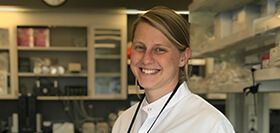Everyone has a baby story that they’ll never live down. Emily Voigt PhD’14’s kid will forever be known as the baby who almost prevented her mom from developing vaccine technology during the coronavirus pandemic of 2020.
“I was working furiously to try to get that grant application submitted before I went into labor,” Voigt says. “My wonderful grants manager told me after the fact that he had contingency plans for what would happen if I went into labor in his office before everything got submitted.”
But even a newborn didn’t keep Voigt out of the lab for long.
“I just came back from maternity leave early to tackle this because I feel like I need to be a part of this process,” Voigt says. “[My team and I] have been coming to work throughout the pandemic. There’s not much staying at home for us. We are here to try to make a difference.”
Voigt is a vaccine researcher at the Infectious Disease Research Institute (IDRI) in Seattle, Washington. She is also the head of their new RNA Vaccine team, which oversees several initiatives regarding both the development of new vaccines and the enhancement of existing vaccine technology.
“I think vaccines are one of the most amazing applications of [immunology research],” Voigt says. “They’re also one of the most impactful ways that we can apply what we know about the immune system and viruses to really better human health on a global scale.”
At IDRI, Voigt and her team study RNA vaccine technology — what she calls “the vaccine of the future.”
“RNA vaccines are these really cool new technologies where you can have a platform [that] is the basis for a vaccine that works. You can have it all tested against one pathogen. You can have it in humans in clinical trials for one pathogen,” Voigt says. “Then, when another disease shows its ugly face, you can swap out the 5 percent of the RNA that targets the particular pathogen for the 5 percent of the new pathogen. Then, you have something that should have the same safety profile, drug profile, and product profiles of your previous product that you can get into the clinic very quickly.”
RNA vaccines are unique in the field of vaccine technology in that they are quicker to manufacture and have a high stability when frozen, rendering them easier to stockpile and to distribute. Unlike traditional vaccine formulations, they do not employ a live or attenuated version of the virus against which they immunize, making them safer.
According to Voigt, older vaccine technology isn’t conducive to rapid responses to the arrival of a new pathogen, much less a pandemic. RNA vaccines offer the best option for combatting COVID-19: they are the quickest to adapt to a new disease.
“That's where I see myself at IDRI in the future,” Voigt says. “Being poised at that place to see a new pathogen come out and very rapidly jump in and tune a new vaccine to protect against it and get it into the clinic and protecting people as safe as humanly possible.”
The Path to Vaccine Research
Before arriving in Seattle, Voigt studied early-stage cellular responses to viral infection while working on her PhD in chemical and biological engineering at the newly opened Wisconsin Institute for Discovery.
“There are long-term immune responses that most people are familiar with [such as] making antibodies to a very specific virus,” Voigt says, “but in most cases, when you first get sick, there are very initial immune responses that help corral the virus before it really takes hold in your body. I was looking at immune responses of human lung cells to various viruses that might land in your lungs.”
Voigt’s fascination with viruses and immunology continued during her time as a post-doctoral fellow at the Mayo Clinic, where she studied the ways existing vaccines behaved in different populations. This research inspired her to join IDRI, where she could develop new vaccines to target new diseases.
“This is a place where we do research that spans everything from very early stages of discovery research for new vaccines through development,” Voigt says. “Very few places in the world have the capability of doing all the stages of vaccine research in one place. I was very excited to find that at IDRI and join the team here.”
RNA vaccines are not new, but they’ve become far more effective in recent years. IDRI’s patented nanoparticle ferries RNA into the cells to induce an immune response far more efficiently than that of previous platforms. Under a $16 million grant from the National Institutes of Health, Voigt and her team are currently hard at work developing a dual vaccine that immunizes against both Zika virus and yellow fever. The project is on track to progress from preclinical research through phase one clinical trials in humans in less than five years.
“There is some overlap in the world between where you get yellow fever outbreaks and places the Zika virus is circulating. A vaccine to protect against both makes a lot of sense,” she says.
According to Voigt, the need for a Zika vaccine was made clear by a 2015 pandemic. Additionally, the existing yellow fever vaccine is notoriously difficult to manufacture and already faces worldwide supply shortages.
“The idea is to have a bivalent vaccine that protects against both things, [is] easy to manufacture, and can get to those populations that need it badly,” Voigt says.
Voigt is also the principal investigator on a two-year Congressionally Directed Medical Research Discovery Grant, “Genetic Adjuvants for RNA Vaccines,” for the Department of Defense.
“While the Zika and yellow fever project is creating a new vaccine with our existing RNA vaccine platform, [the DoD grant] is looking at ways to further improve our base platform, ways to adjuvant it: to be able to tune the immune responses to what we want to ideally see,” Voigt says. “You could potentially change up what types of immune responses you get from the vaccine depending on what target you’re looking to make a vaccine for.”
Harkening back to her Mayo Clinic days, Voigt marvels at the strides made in eradicating widespread disease using vaccine technology, and the potential for continuation of this trend with diseases yet to be tackled.
“When you think of all the diseases that humanity had to deal with — polio, smallpox, et cetera — that we really don’t have to deal with nowadays because of vaccine technology, that’s really cool stuff,” she says. “One of the best things you can do as a scientist is impact humanity on that sort of level.”
The Race for a COVID Vaccine
As the world grapples with a disease it wasn’t prepared for, Voigt reminds those anxiously awaiting a vaccine that though expediency is desired, it takes time to get this meticulously researched and rigorously tested technology right.
“What people hear in the media about this process typically taking decades is the truth. We are talking about fast-forwarding the process and speeding it along at really an unprecedented speed,” Voigt says. “Even if we’re going to get a vaccine available in the next two years, there are big safety questions. We want to 100 percent be sure that these vaccines against COVID are safe and effective before we start vaccinating millions of people.”
Voigt and her team were recently tapped to start work on a vaccine to protect against SARS-CoV-2, the virus that causes COVID-19. Thanks to the RNA vaccine platform, IDRI’s COVID-19 vaccine could be readily adapted should the virus start mutating, or should another coronavirus emerge to ignite another pandemic.
“We think of ourselves as part of that footprint optimization process to create really optimized vaccine candidates that will induce long-lasting, protective immunity against this and potentially other coronaviruses,” Voigt says.
Voigt is excited by the sudden interest the world has taken in the research and technologies she has been keenly aware of — or taken part in — for years.
“As a vaccine researcher, if you’re doing your job well, humans aren't getting sick. Usually we fly under the radar. Suddenly, vaccine research is on the forefront of everybody’s mind, which is certainly an interesting change,” Voigt says.
Whether she’s working in anonymity or standing at the center of a fight against a virus, Voigt intends to see the proliferation of RNA vaccine technology go from untapped potential to a readily available means of pandemic prevention — but why stop with viruses?
"There’s a whole new field of vaccines against cancer and gene delivery and things like that that we could also adapt our new technology to,” Voigt says. “That’s where I see things going in the future: I see us at IDRI poised to be ready to respond very rapidly to the next pandemic, hopefully minimizing the impact that these pandemics can have on populations worldwide."







